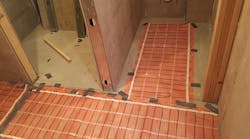For electric space-heating cable installations such as the type shown in the Photo, Sec. 424.47 requires manufacturers to provide marking labels indicating that the installation incorporates space-heating cables. These marking labels are required to be affixed to the panelboards to identify which branch circuits supply the space-heating cables. This is where the Code wording gets a little fuzzy. Should these labels really be installed on the panelboard itself? Or perhaps it would be better to install them on the cover of the enclosure for the panelboard?
Article 100 defines a panelboard as “a single panel or group of panel units designed for assembly in the form of a single panel, including buses and automatic overcurrent devices, and equipped with or without switches for the control of light, heat, or power circuits; designed to be placed in a cabinet, enclosure, or cutout box placed in or against a wall, partition, or other support; and accessible only from the front.” I really don’t think the intent of Sec. 424.47 is for the labels to be installed on the busbar assembly.
I believe the intent of Sec. 424.47 is to have the labels installed on the cover of the cabinet or enclosure for the panelboard. Using the term “panelboard” as a generic catch-all term to include the busbar assembly, overcurrent protective devices, enclosure, cabinet, and cover is a very common occurrence in the electrical industry. I’m guilty of it myself. But the reality is that definitions matter, and panelboard, enclosure, cabinet, and cutout box each have their own definition in Art. 100.
There are many other instances in the Code where the literal term “panelboard” is used but the intent of wording is probably referring to the “enclosure” or “cabinet” for the panelboard instead of the panelboard itself. For example, Sec. 250.32(D)(3) states “the connection between the equipment grounding conductor and the grounding electrode at a separate building or structure shall be made in a junction box, panelboard, or similar enclosure located immediately inside or outside the separate building or structure.” I’m pretty sure the use of the term “panelboard” here is really meant for the “cabinet” or “enclosure” for the panelboard.
When you have a moment, check out any rules where the term “panelboard” is used, and see if you think the Code is referring to the enclosure for the panelboard or the panelboard itself. If you are unsure, I suggest having a conversation with your AHJ to try and figure out these sometimes confusing rules.





